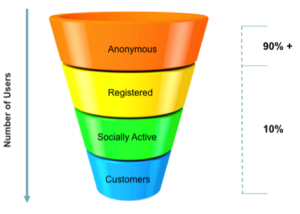As we all know, Publishers and media organisations have been dealing with a massive power shift from their readers, with a vast majority actually wanting to access content online. Previously, it was simple, a user wanted a newspaper or magazine they’d go to the shop, and buy an item. The publisher would get a cut of the money simple.
But how exactly do you police this online? With social media outlets Twitter and Facebook so easy to access these days, nobody is going to log online to pay to read one article. So this therefore begs the question, how do you monetise your content successfully in this current climate?
Essentially, if content is a main component of your organisation, then you’ll need a way to successfully monetise the whole operation. Now with the Evolok platform, this process is broken down into a series of stages to make things easier.
One way to easily visualise things, is to look at the whole process as a funnel ( see fig.1).
 fig.1
fig.1
What we’re trying to do is tap into the anonymous user market, and then take them on a journey to turn them into a paying subscriber.
-
Anonymous Users
Anonymous users make up a whopping 90% of web users. This is where the challenge begins. How do you turn these users into consumers? The answer is data. A good way to start doing this is by using cookies. Cookies are brilliant, as by looking at a user’s cookies, you can see what websites they’ve previously been on and searched for. You can also already begin to segment a user due to this. At this stage, we’ve already begun building a profile on the anonymous user, which triggers the next stage of the journey.
-
Profiling
Once an anonymous user has started to engage, and you’ve already begun gathering information on them. The next stage would be to attempt to gather details from the anonymous user. Registration allows you to build a more detailed profile for the user. This is handy way to find out what your user’s demographics and basic details are. From this stage, you can get a pretty good idea on what kind of person your anonymous user is.
-
Segmentation/ Personalisation
Now that you’ve begun to personalise, you can begin to segment your users. This can be done by defining key user segments based on profile data, (such as age, gender, location, services subscribed to etc.). That can be used to further refine the experience to the user’s persona to make the personalisation stage even better.
Read about the personalisation and segmentation stage here
-
Paywall
Finally, now that you’ve built an extensive profile on your anonymous user, and have sent them personalised ads and offers, you can then begin to try and monetise your users. What we’ve all been waiting for.
Usually, The target for publishers when introducing a wall of any kind should be the top 10% of users.
This group is broken down as follows:
- Regular daily engagement with the site and receptive to marketing activity
- Longstanding customers who have registered for a long period of time
- Registered to affiliate sites on the property
Now the main reason you’d try and monetise the top 10% is because of the loyalty and the relationship you’ve already built with them. If they’re a user who have been registered for some time, you most likely have developed some kind of rapport with them. It’s much easier to monetise someone that you have a sense of loyalty to, as opposed to a brand new user.
Because of social media and the ability to access so much content, users are very used to accessing free content, and as a result of this, the monetisation journey has never been so important. Have a read of our previous blogs on engagement and what a successful monetisation strategy comprises of. Contact Evolok for a further demo.
